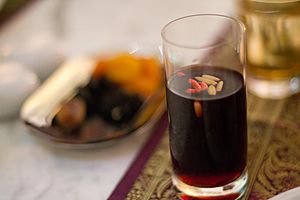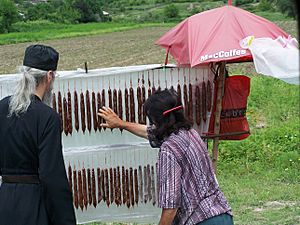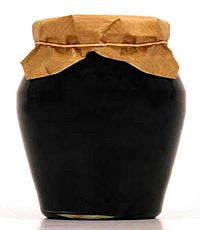Grape syrup facts for kids


Grape syrup is a sweet, thick liquid made from concentrated grape juice. It's similar to other fruit syrups and is very sweet because it has a lot of sugar and not much water. To make it, grapes are boiled, their skins are taken off, and then they are squeezed to get the juice. Sugar is often added to make it even sweeter. People often use grape syrup as a topping for sweet foods like pancakes or waffles.
Contents
What is Grape Syrup Called?
Grape syrup has many different names around the world.
Ancient Names
In ancient Greece, grape syrup was called siraios (σιραίος). This word came from a general term, hepsema (ἕψημα), which means 'boiled'. This name was used in places like Crete and is still used in Cyprus today.
Petimezi
Petimezi is a common name for grape syrup in the Mediterranean region. This word comes from the Turkish word pekmez. While pekmez usually means grape syrup, it can also refer to syrups made from other fruits like mulberry.
Vincotto
In southern Italy, grape syrup is called Vincotto. It's made from cooked grape juice (called mosto cotto) that has not been fermented. This means it doesn't have any alcohol or vinegar. No extra sugar or preservatives are added. Vincotto is used in both sweet and savory dishes.
A Sweet History of Grape Syrup
Grape syrup has been around for a very long time!
Grape Syrup in Ancient Times
One of the first mentions of grape syrup comes from Hippocrates, a Greek doctor who lived in the 400s BC. He called it hépsēma. Other ancient writers, like the Greek playwright Aristophanes and the Roman-era Greek doctor Galen, also wrote about it.
In Ancient Roman cuisine, grape syrup had different names depending on how much the grape juice was boiled down.
- Carenum was grape juice boiled down to two-thirds of its original amount.
- Defrutum was boiled down to half its original amount.
- Sapa was boiled down to one-third of its original amount.
The Greek name for this type of grape syrup was siraion.
Romans used defrutum to help keep wine fresh and to make it sweeter. They also added it to fruit and meat dishes for a sweet and tangy flavor. Sometimes, they even gave it to animals like ducks to make their meat taste better. Roman women also used defrutum or sapa as a cosmetic. It was also a good way to preserve food for Roman soldiers.
There was some confusion among ancient writers about exactly how much grape juice was reduced for sapa and defrutum. Different authors gave different amounts. For example, Pliny the Elder suggested boiling defrutum only during the new moon. Cato the Elder said that only the sweetest defrutum should be used.
Lead and Grape Syrup
In ancient Rome, grape syrup was sometimes boiled in lead pots. This made the syrup sweeter because a chemical called lead acetate, which tastes sweet, would mix into the syrup from the lead pots. However, this could cause lead poisoning for the Romans who ate the syrup.
Modern tests on historically made defrutum in lead pots showed very high levels of lead. These levels were high enough to cause serious health problems if eaten regularly. However, it's important to know that copper pots were used more often than lead pots. Also, experts still debate how much lead was actually in these ancient Roman foods and how often it was a problem.
Modern Uses of Grape Syrup
Cyprus
In Cyprus, people still make grape syrup and call it hépsēma (now pronounced épsēma in Cypriot Greek), just like in ancient times.
Greece
| Nutritional value per 100 g (3.5 oz) | |
|---|---|
| Energy | 1,380 kJ (330 kcal) |
|
80.9 g
|
|
|
0.4 g
|
|
|
Protein
|
0.9 g
|
| Minerals | Quantity
%DV†
|
| Calcium |
7%
74 mg |
| Iron |
9%
1.2 mg |
| Phosphorus |
6%
40 mg |
|
Varkazas, p. 203
|
|
| †Percentages estimated using US recommendations for adults. | |
In Greece, Petimezi (Greek: πετιμέζι) is a dark, thick syrup made by boiling down grape juice. It can last a very long time. It tastes sweet with a slightly bitter touch. The color can be light or dark depending on the grapes used. Before sugar was easy to find, petimezi was a common sweetener in Greek cooking, along with carob syrup and honey. Today, petimezi is still used in desserts and as a sweet topping. You can make it at home or buy it in stores.
Fruits and vegetables that are candied by boiling them in petimezi are called retselia. From late August to early December, many Greek bakeries sell crunchy and fragrant petimezi cookies, called moustokoúloura (Greek: μουστοκούλουρα). There is also a spiced cake made with petimezi called petimezopita (Greek: πετιμεζόπιτα).
Iran
In Iranian cuisine, grape syrup (called Persian: شیره انگور) is used to sweeten ardeh (which is tahini). People often eat this for breakfast. Another common sweetener in the Middle East is date syrup.
Italy
In Italy, Saba (from the Latin word sapa), vincotto, or vino cotto is commonly used. It's a traditional flavor in regions like Emilia-Romagna, Marche, Calabria, and Sardinia.
North Macedonia
In North Macedonia, a type of grape syrup called Madjun (Macedonian: Гроздов маџун) has been made for hundreds of years. It's used as a sweetener and also as a traditional medicine. It never has any added sugar.
South Africa
In South Africa, grape syrup is known as Moskonfyt.
Spain
Arrope is a type of grape concentrate made in Spain. It's often made from grape types like Pedro Ximénez. To make it, unfermented grape juice is boiled until its volume is cut in half and it becomes a thick syrup. The final product is a thick liquid with flavors like cooked caramel. It's often added to dark, sweet wines like sherry, Malaga, and Marsala.
Turkey
In Turkey, grape syrup is known as pekmez.
The Levant
In the Arab countries of the Levant (Jordan, Palestine, Lebanon, and Syria), grape syrup is called Dibs al-anab. In Israel, it's called Davash Anavim. Both names mean "Grape Honey." It's usually used as a sweetener and in desserts, along with carob syrup and bee honey. In Israel, it's also used to sweeten wine and is eaten with leben (a type of yogurt) and toasted nuts like walnuts and almonds for breakfast.
See also
 In Spanish: Arrope para niños
In Spanish: Arrope para niños



